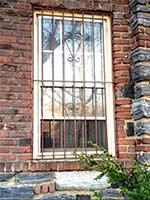Martial Arts: Home Security and Defense
Self Defense For Your Home
By Christopher Caile

This front of this home is free of bushes and trees that hide windows or doors and thus provides a clear view from adjacent houses and from the street. Thus, in front at least, there is no place for intruders to hide while trying to break in. Trees on the side of the house are another matter. They do obscure vision and thus provide a measure of privacy – not good for security.
You can't always be home to protect your valuables. Most home break-ins are committed by those who are looking to score quick and easy. Don't make it easy and make the quick more difficult. There are steps you can take to help keep your home more secure which will discourage the less committed.
Install A Home Security System Or At Least Decals
Most intruders or burglars try to avoid trouble. The simple fact that your home may be alarmed prompts many intruders to find greener pastures elsewhere. Therefore a simple alarm company decal displayed on the front door or its windows (and rear also if you have one) of an apartment or home will fend off the more skittish. Of course this can not actually stop a determined intruder.
Neither will an alarm from an installed system. It too may not stop an intrusion but if loud enough it might prompt a quicker exit. There are a lot of wireless self installable systems available that might fit this purpose. Security system monitoring is an extra important step that alerts a company monitoring station of an alarm so that law enforcement can be contacted and respond if you are not at home. But perimeter security systems also have limits. They can often be breached without setting off an alarm – its costly to alarm every window and door as well as basement access. Thus, a security system is greatly beefed up by including some kind of inside the house motion protection or beam (that if broken sets off the alarm).
A Dog Can Be An Alarm & A Threat To Intruders
 |
Seeing a "Beware of Dog" sign will make most potential intruders think, "Do I want to avoid this potential trouble?" If your house has not been specifically targeted, an intruder looking for opportunity may just move on. |
A dog in your home can also serve as a live alarm. Dogs' hearing and sense of smell are very acute. They can sense potential intrusion before you do, although false alarms are often prevalent. Overall, however, dogs can serve as an excellent early warning system, if you are there. But if you aren't, and they sound threatening, dogs can give a potential intruder pause. Dog bites can be painful. They can also be difficult to deal with. Even a small dog with a high pitched yap can sound an alert, and nip an intruder's heels. I knew a guy in Buffalo who rigged up his homemade security system not to an alarm but to a recording of a large vicious dog barking. He swore by it.
Posting a "Beware Of Dog" sign can also be a deterrent. So can an actual dog outside the home (as many postmen can well attest). A dog house that is easily seen can serve as another deterrent.
Keeping On An Inside Light And A Radio, Using Timers

This house sits completely dark at night along a populated city street in the Bronx, NY. There is no indication that anyone is at home. It is almost an invitation.
If you live in a house, your absence is often signaled by the absence of lights or sounds. At night a dark, quiet house with no car in the driveway gives out a sort of welcome sign to the unwelcome. So if away, keep a light on. Maybe even a radio or TV. Even better, keep lights or radios on timers when not at home. Their going on and changing location will look like someone inside is moving around.
External Lighting
 |
This apartment building uses outdoor flood lights at night to illuminate side areas of the structure vulnerable to break-in. |
One counter measure to beef up a house's exterior when it is dark outside is to install exterior flood lights. They provide decorative accent and make your exterior potentially visible to neighbors, those on the street and in passing cars. This advice doesn't apply to front porch lights. They signal that someone is expected and when coupled with a dark house this combo signals that this someone is you or a member of the family and that no one is home presently.
Another variation of light used as a counter measure is to install motion activated lights. An important location for these is around driveways. Thus when you pull into your driveway the immediate area will be lit. These same lights are also useful in the back yard or on exterior decks. If people are creeping around, sudden lighting is unexpected and will scare the less determined. They can also alert you to movement outside.
 |
In this close up of a home's front door area, tall bushes around the front doorway give intruders a place to hide. Even worse they give attackers a place to wait for you unobserved. |
Pros & Cons of Bushes & Trees
The more secluded your house is, the less threatening will be your home's exterior. Bushes and trees around windows or entrances might look great, but they also provide cover. So if possible, keep bushes to a minimum and if they must be there keep them cut low.
Some people plant prickly green bushes in their yard or under windows as a deterrent. A good option for under windows is a rose bush, but there are many other thorny options too. Check with a local gardening center for advice. Cost, maintenance and local climate considerations need to be considered. Thorny bushes might provide just enough ouch factor to secure window areas from those who are not dedicated.
Parameter Barriers
Another green security option is to build a prickly hedge as a barrier around your property. Similarly, a wire, wood or metal fence can be used for the same purpose. But as with tall greenery, if your fence is tall and can't be seen through, it becomes a screen.
Many years ago when living in Washington, D.C. I was invited to visit a friend's home. It was in a very rough part of town. When I arrived, I found his home ringed by a high metal fence and roaming around inside were three very scary looking, aggressive Doberman dogs — not a place I would venture into unannounced.
Fortifying Your External Points of Entry
 |
This ground floor apartment window on a Bronx, NY apartment is protected from intrusion by heavy metal bars – good advice for lower floors in urban and other crime prone areas. |
This means that when you are out, keep your doors locked and windows too. If you have sliding glass doors don't just lock them but insert a long square piece of wood to fill the slide path of the glass door.
As to most door locks, they are pretty pathetic in terms of protection. Doors are too. The best doors are made of thick wood. Locks should include the added protection of deadbolts. The lock should also include a strong strike plate (that attaches to the door frame). Many of these are flimsy. You want your lock to resist an attempt at resist forced entry and hammering.
You also want your door lock to resist picking. Pick a high security lock such as made by Medeco. They are more costly, but are worth it since they are almost impossible to pick. Most high security locks also feature hardened cylinders. They can frustrate attempts to drill them out to gain entry.
If you live in a basement or first floor apartment in an urban area or an area that is not secure from crime, make sure there are window bars or at least heavy wire screens. Some people in more secure areas just seal their windows and as a fail-safe, They often also utilize a security system that monitors the window glass for break-ins. If you live on a higher floor be sure there is a barrier fortifying an escape window to a fire escape. Remember a fire escape can be used as an entrance to your apartment too.
The Question Of Keys
No lock is secure if copies of its keys get into hands of criminals. Too many people move into apartments or homes and just keep using the keys they were originally given. Over time the keys they inherited may have been given out to family members, neighbors, friends, professionals doing work inside the residence and others. In short: the keys you inherited with your new residence may have been compromised.
The same process can happen with you. Even when you start with new locks and keys, over time you can easily lose control of who has access to entry. So change your locks when you move. And if you give keys out, keep the duplicates at a minimum and distributed only to the most trusted. Also consider limiting duplicate keys to just one entry door and have the lock(s) changed on a timely basis. Another solution is to install a keyless touch pad entry system. While they have the option of allowing codes to be easily changed (a good security feature), many of these locks have also proven to more easily tampered with and broken. So be careful in you decisions. Get advice from you local locksmith.
Conclusion
When I finished this article I showed it to my wife and asked for her opinion. After reading it she said, "Isn't this all just common sense?" "Yes," I replied. "But as Mark Twain is often quoted as saying, 'Common sense is very uncommon.' " And after driving around local streets and neighborhoods, especially in the evening and night, I saw house after house making every security mistake in the book. Many were just inviting unwanted visitors. So think about your house and its security. A few small changes could save you a lot of headaches later.
About the Author Christopher Caile

Screenshot
Christopher Caile is the Founder and Editor-In-Chief of FightingArts.com. He has been a student of the martial arts for over 65 years.
He first started in judo while in college. Then he added karate as a student of Phil Koeppel in 1959 studying Kempo and Wado-Ryu karate. He later added Shotokan Karate where he was promoted to brown belt and taught beginner classes. In 1960 while living in Finland, Caile introduced karate to that country and placed fourth in that nation's first national judo tournament.
Wanting to further his karate studies, Caile then hitch hiked from Finland to Japan traveling through Scandinavia, Europe, North Africa, the Middle East and South and Southeast Asia — living on 25 cents a day and often sleeping outside.
Arriving in Japan (1962), Caile was introduced to Mas Oyama and his fledgling full contact Kyokushinkai Karate by Donn Draeger, the famous martial artist and historian. Donn also housed him with several other senior international judo practitioners. Donn became Caile's martial arts mentor, coaching him in judo and introducing him to Shinto Muso-ryu under Takaji Shimizu.
Caile studied at Oyama's honbu dojo and also at Kenji Kurosaki's second Tokyo Kyokushinkai dojo. In his first day in class Oyama asked Caile to teach English to his chief instructor, Tadashi Nakamura. They have been friends ever since. Caile also participated in Oyama's masterwork book, "This Is Karate."
Caile left Japan with his black belt and designation as Branch Chief, the first in the US to have had extensive training in Japan directly under Oyama Sensei. As such, Oyama Sensei asked him to be his representative on visits to his US dojos to report on their status.
A little over a year later, Nakamura, Kusosaki and Akio Fujihira won an epic David vs. Goliath challenge match against Thailand's professional Muay Thai Boxers in Bangkok, Thailand, thrusting Kyolushinkai and Nakamura into national prominence.
Back in the US Caile taught Kyokushinkai karate in Peoria, Il while in college and later in Washington, DC. while in graduate school. Durimg this time Shihan Nakamura had moved to New York City to head Kyokushinkai's North American Operation.
In 1976 when Kaicho Tadashi Nakamura formed the World Seido Karate organization, Caile followed. Living then in Buffalo, NY, Caile taught Seido karate and self-defense at the State University of New York at Buffalo (SUNY Buffalo) for over 15 years where he also frequently lectured on martial arts and Zen in courses on Japanese culture.
Caile moved to New York City in 1999 to marry Jackie Veit. He is now an 8th degree black belt, Hanshi, training in Seido Karate's Westchester, NY Johshin Honzan (Spiritual Center) dojo. In Seido Caile is known for his teaching of and seminars on kata applications. He also produced a 14 segment video series on Pinan kata Bunkai currently available to Seido members.
Caile is also a long-time student and Shihan in Aikido. He studied in Buffalo, under Mike Hawley Shihan, and then under Wadokai Aikido's founder, the late Roy Suenaka (uchi deshi under Morihei Ueshiba, founder of Aikido and was Shihan under Tohei Sensei). In karate, Suenaka (8thdan) was also an in-house student of the Okinawan karate master Hohan Soken.
Having moved to New York City, Caile in 2000 founded this martial arts educational website, FightingArts.com. Twenty-five years later, in 2025, it underwent a major update and revision.
For FightingArts.com and other publications Caile wrote hundreds of articles on karate, martial arts, Japanese art, Chinese Medicine and edited a book on Zen. He also developed relationships with a cross section of leading martial arts teachers. Over the last four decades he has conducted extensive private research into karate and martial arts including private translations of the once secret Okinawan hand copied and passed on Kung Fu book, the Bubishi, as well as an early karate book by the karate master Kenwa Mabuni. He periodically returns to Japan and Okinawa to continue his studies and participate Seido karate events. In Tokyo he practiced (with Roy Suenaka Sensei) in a variety of aikido organizations with their founders – including private interviews and practices at the Aiki-kai Aikido Honbu dojo with the son and grandson of aikido's founder, Doshu (headmaster) Kisshomaru (an old uchi-deshi friend) and his son, Moriteru Ueshiba and in Iwama with Morihiro Saito. On Okinawa he studied Goju Ryu karate under Eiichi Miyazato, 10th dan founder of Naha's Jundokan, and also with Yoshitaka Taira (who later formed his own organization, who specialized in kata Bunkai. While there Caile also trained with Hohan Soken's senior student, Master Fusei Kise, 10 dan as well as with the grandson of the legendary karate master Anko Itosu.
Caile's other martial arts experience includes: Diato-ryu Aikijujitsu and Kenjitsu, kobudo, boxing, Muay Thai, MMA, Kali (empty hand, knife and bolo), study of old Okinawan Shoran-ryu & Tomari body mechanics, study of old Okinawan kata under Richard Kim, study of close quarter defense and combat, including knife and gun defenses, Kyusho Jitsu and several Chinese fighting arts including 8 Star Praying Mantis, Pak Mei (White Eyebrow), and a private family system of Kung Fu.
Caile is also a student of Zen as well as a long-term student of one branch of Traditional Chinese Medicine, Chi Kung (Qigong). As one of two senior disciples of Chi Kung master Dr. Shen (M.D., Ph.D.) Caile was certified to teach and practice. This led to Caile's founding of the The Chi Kung Healing Institute on Grand Island, NY. In Western NY, he also frequently held Chi Kung seminars, including at SUNY Buffalo and at the famous Chautauqua Institution in Chautauqua, NY. His articles on Chi Kung also appeared in the Holistic Health Journal and in several books on alternative medicine.
Caile holds a BA in International Studies from Bradley University and MA in International Relations with a specialty in South and Southeast Asia from American University in Washington, D.C. While in Buffalo, NY he also studied digital and analog electronics.
In his professional life Caile also worked in public relations and as a newspaper reporter and photographer. Earlier he worked in the field of telecommunications including Managing a Buffalo, NY sales and service branch for ITT. He then founded his own private telephone company. This was followed by creation of an electrical engineering company that designed and patented his concept for a new type of low-cost small business telephone system (which was eventually sold to Bell South). The company also did contract work for Kodak and the US space program. Simultaneously Caile designed and manufactured a unique break-apart portable pontoon boat.
Most recently Caile co-founded an internet software company. Its products include software suites with AI capability for control and management of streaming media, such as video and music, an all-in-one book publishing software product for hardcover, eBook and audio book creation and security software for buildings and government use.
For more details about Christopher Caile's martial arts, work experience and life profile, see the About section in the footer of this site.
Search for more articles by this author:






